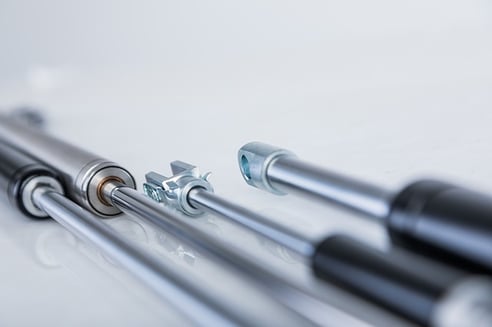
Some lids close gently. Others seem to wait until your hand is nearby, then drop like a trap.
In industrial and commercial settings, that kind of surprise can lead to downtime, damage, or bruised pride. It’s one of the reasons many engineers start looking into gas spring replacements or completely different alternatives.
Gas spring hinges are common in motion control design, but they don’t always hold up to heat, wear, or repeated use. Internal pressure changes, oil leaks, and faster-than-expected failure rates can make maintenance a recurring hassle. When reliability matters, many engineers choose to replace gas spring hinges with mechanical supports.
This article looks at when and why that switch happens – and where mechanical spring hinges offer more predictable, long-term performance.
Mechanical Gas Spring Replacements and Their Practical Advantages
Gas spring hinges handle medium-duty loads and achieve the purpose intended for various industries, from hospitality to defense. However, gas springs require optimal conditions for the preferred outcome. When it comes to extreme temperatures, for example, the reliability of a gas spring hinge declines significantly. This is not the only concern when gas spring hinges are in a design.
For some situations, such as the medical field, the potential for an explosion is an issue with gas spring hinges. Meanwhile, for industrial situations, the deterioration can mean more money spent to replace the hinges on a regular basis. This can be a hit to the budget and incentive to choose the mechanical spring replacement.
When Should You Send Gas Springs Packing?
While we have covered gas spring hinges and their potential downfalls in previous blogs, there are three main points of consideration: Unpredictability, Deterioration, and Recyclability. Often, as opposed to their mechanical spring replacements, gas springs fall short:
- Unpredictability: Environments with significant shifts in temperature can be less than ideal for gas spring use. Not only do gas spring hinges deteriorate quickly in extreme temperature changes, but there is also a risk of explosion when the gas in the springs is exposed to higher temperatures. (This is due to a higher internal pressure in the spring.) There is also a risk of oil leakage from a gas spring, which means potential contamination of its surroundings.
- Deterioration: As noted above, temperature changes means faster deterioration rates for gas spring hinges. Withstanding major shifts in temperature, when compared with their mechanical spring hinge replacements, Gas Springs often deteriorate faster in general.
- Recyclability: Today’s society is focused on sustainability and products that account for the opportunity to recycle in their manufacturing and packaging. Therefore, gas spring hinges are less ideal because they have to be recycled in pieces rather than as a whole.
When to Use – and Avoid – Gas SpringsGas springs have their uses. However, they can be troublesome for certain industries. For example, the potential for leaks can be problematic for the medical industry. If you have gas springs installed on a product and are considering a switch, read more below:
|
When Mechanical Hinges Make More Financial Sense
Gas spring hinges often seem like the more affordable choice up-front. For teams working within a tight budget, that initial price point can be appealing. But when replacements are needed more frequently, long-term costs can add up.
Mechanical spring systems typically have a higher starting cost but tend to last longer in demanding environments. Over a 5-year span, fewer replacements and less maintenance often offset the initial investment.
For applications that see heavy use or need consistent motion control over time, like commercial kitchen equipment or medical enclosures, many teams weigh that tradeoff carefully – and choose the option that better fits their long-term plans.
FAQs About Gas Spring ReplacementsIf you're considering a switch from gas springs to mechanical alternatives, these common questions can help clarify what to expect. Q: What types of mechanical spring hinges can replace gas springs?A: Common mechanical replacements include counterbalance hinges, spring-assisted hinges, and torsion springs. These designs manage lid motion without relying on gas or internal pressure. Counterbalance hinges work well for heavier lids, while spring-assisted and torsion springs are suited to lighter or moderate-duty applications. The best option depends on load, usage, and environment. Q: How do gas and mechanical springs compare in weight capacity and control?A: Gas springs provide smooth motion for medium-duty loads, but performance drops in extreme temperatures due to pressure fluctuations. This can lead to faster failure or inconsistent movement. Mechanical springs offer stable, repeatable control across a wider range of conditions. They’re often better suited for environments with heat, cold, or heavy use. Q: How long do mechanical hinges last compared to gas springs?A: Mechanical hinges typically last 3-5 years, even under demanding conditions, while gas springs often require replacement after 1-2 years due to leaks, pressure loss, or wear. That added durability can reduce maintenance costs and downtime. |
Where Mechanical Hinges Often Replace Gas Springs
Some hinges don’t fail all at once, they wear out quietly. In places like restaurants, hotels, or outdoor kitchens, that wear shows up faster than expected. Heat, humidity, and constant use take a toll, and gas spring hinges don’t always keep up.
That’s why some teams move toward gas spring replacements with mechanical spring designs. There’s no pressurized gas to leak or break down, and performance tends to stay consistent over time. For equipment used day in and day out, the more predictable option often makes the most sense.
Have Questions About Your Hinge?
Not sure what makes sense for your setup? Talk it through with an engineer.
 This article was originally published in June of 2021 and was recently updated to reflect current industry trends.
This article was originally published in June of 2021 and was recently updated to reflect current industry trends.
.png?width=12000&height=2033&name=WeberKnappLogo_white%20(1).png)

